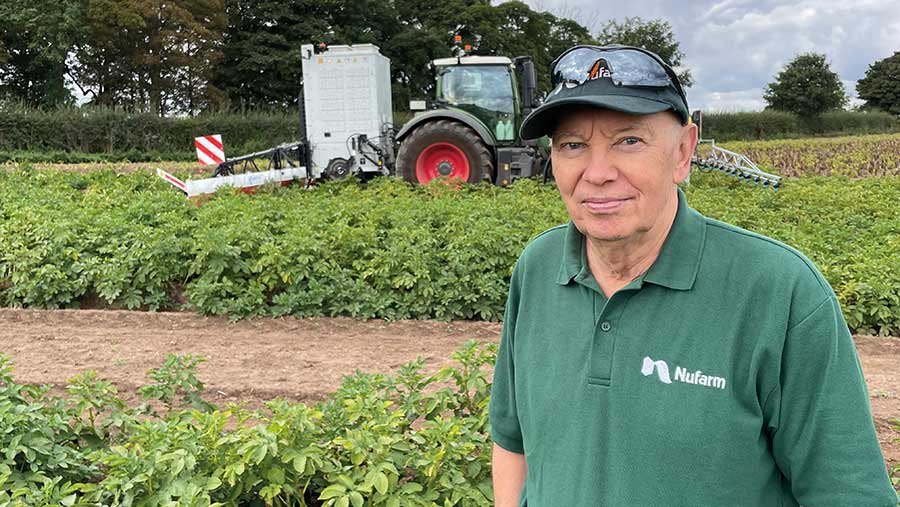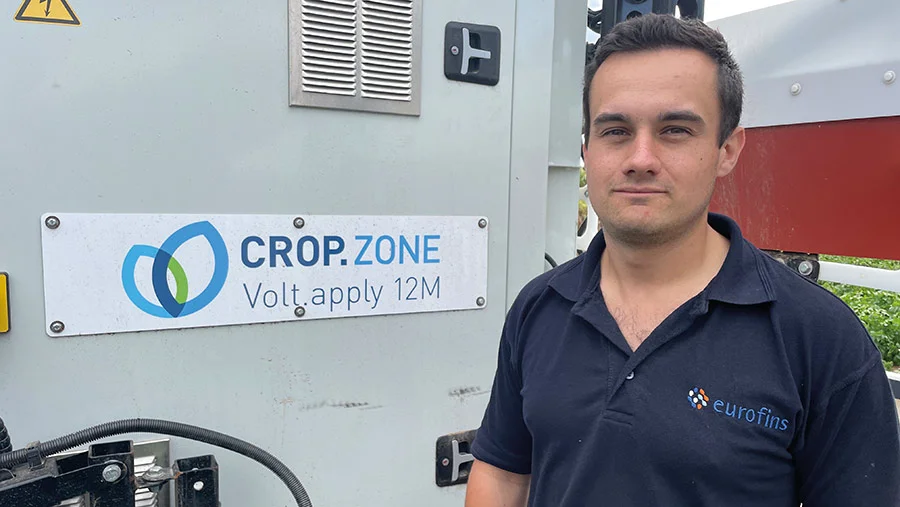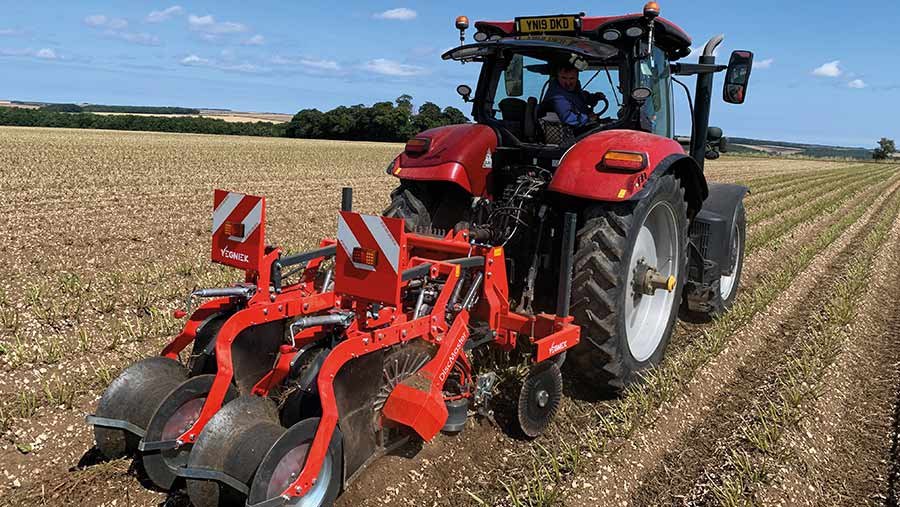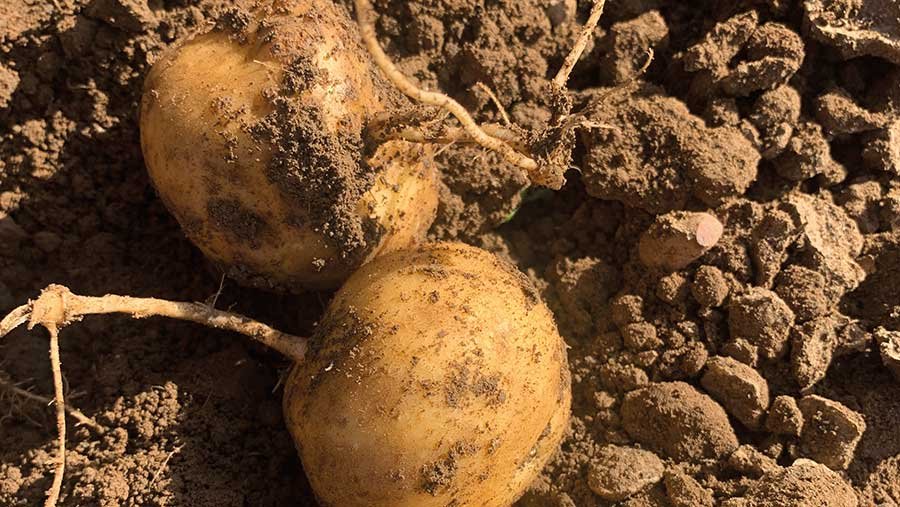Two alternative means of desiccating potato crops were trialled during the 2022 season and both machines offer potential, although more work is planned to optimise use in British conditions.
The key to successful potato desiccation is rapid kill of all green material above ground, reducing the risk of late-season virus transmission and foliar disease development.
This also hastens skin set and stolon detachment, allowing a timely harvest in decent field conditions, leaving tubers less exposed to soil-borne diseases.
See also: High-tech potato-grading line ups profits for Cornish grower
Available chemical options, the PPO-inhibiting herbicides Gozai and Spotlight, can work well on their own given the right conditions – bright and sunny.
But if conditions are not ideal, they can be slow and sometimes require up to four applications (two of each) to get the job done.
Since the loss of diquat, most farms have moved to a flail and spray technique, mechanically removing the bulk of the haulm before using PPOs to kill the remaining leaf and stem.
While many have made this system work, flailing is not the preferable option in all situations, with seed producers in Scotland particularly averse due to the potential spread of pectobacterium atrosepticum, which causes blackleg.
This has ignited interest in alternatives, and work carried out in recent seasons to test their worth is starting to build a picture on where they might fit in future desiccation programmes.
CropZone hybrid electric weeder
One of the options is the Nucrop hybrid weeding system from German engineering company CropZone and agrochemical group Nufarm.
It was tested to destruction in UK trials this year, shedding some light on how it might be used commercially in future seasons.
The system applies a non-toxic conductive liquid – branded Volt.fuel – to the target before passing up to 5,000V through the plants.
The Volt.fuel allows it to work at a lower voltage than other electrical systems.
© Adam Clarke
Electrocution is achieved by floating positively and negatively charged stainless-steel elements over the target. Any plant foliage in contact with both at the same time completes the electrical circuit and gets zapped.
Often there is little weed biomass present in stubbles to complete the circuit, and this is one of the challenges of building the system’s broader market appeal.
CropZone is working on a boom design for stubble management, but until then it is focused on providing an alternative means of potato desiccation, where there is usually plenty of biomass to target.
After early development and proof-of-concept trials, there are now several units working across the Channel, mainly in the Netherlands and Belgium.
Machinery distribution specialist Royal Reesink BV is responsible for sales and leasing of the machine in the Benelux region.
Nufarm makes and sells the Volt.fuel and advises distribution partners on practical application.
Similar dealer and distribution tie-ups are being sought in the UK, with Nufarm’s technical team primed to take on the same technical role, communicating with agronomists and growers.

Richard Dyason © Adam Clarke
For 2022, Nufarm’s UK and Ireland technical manager Richard Dyason had two units to play with, setting up trials in both Scotland and England.
These were designed to tease out strengths and weaknesses before starting some commercial work next year.
Trial sites
Farmers Weekly visited one 2022 trial site in Derbyshire, where the electric system was tested alongside, and in combination with, conventional options such as flailing and PPO herbicides.
Varieties included Slaney, Maris Piper, and Desiree.
In the plots grown for ware, where haulm was beginning to naturally senesce, one pass with the Nucrop produced effective results in both Maris Piper and Desiree.
Slaney, which produces a very vigorous canopy, proved hard to kill with the Nucrop alone.
In the plots grown for seed – seed crops must be killed earlier in their development to avoid tubers getting too big – the system again struggled on its own, although all other treatments did as well.
“What came through clearly this year is that one size doesn’t fit all. If you think you can use the same method across all varieties of seed and ware, it isn’t going to happen,” says Mr Dyason.
This leads him to suggest that the system can get the desired results alone, but it may be necessary to use it as part of a programme with other chemical or mechanical methods, depending on variety, site, and season.
Observations from the work hint that it’s a good precursor to PPO inhibitors, wilting the canopy and opening it up for better spray penetration onto the base and stems, improving efficacy.
Best results were seen when the electric weeder was followed by an application of Spotlight Plus (carfentrazone-ethyl) within 48 hours.
It should be noted that it was a very tough year for desiccation in general, with extremely hot and dry conditions making haulm much tougher to kill. Regrowth was also a problem on the Derbyshire site, particularly in Slaney.
More research is planned in 2023, extending commercial work with farmers and contractors in Scotland and England, along with another trial with Eurofins.
This time, Slaney will be swapped for Cara as a large canopy variety with greater commercial relevance.
Nufarm could not provide an exact price for purchase, lease or per hectare treatment, but it says Nucrop must be competitive with other treatments on a pass-to-pass basis to attract potential users.
As previously published in Farmers Weekly, the demo system is insured for about €250,000 (£215,000), giving some idea on possible retail price. However, that figure is likely to fall if and when production is ramped up.
CropZone operator’s view

Dan Smart © Adam Clark
Driving a machine that kicks out 5,000V is not something the average farm operator is tasked with, so specialist training will be required for those using a Nucrop hybrid weeder.
Eurofins specialist equipment agronomist Dan Smart carried out the trial treatments for Nufarm and he had to complete an online training module on electrical safety basics before being able to do so.
After that, a specialist trainer from Germany spent time with him in the cab to run through the various processes necessary for safe operation.
Mr Smart says there are plenty of fail-safe mechanisms that must align before electricity is switched on, including the flow of Volt.fuel from the front-mounted sprayer and a minimum forward speed
Once up and running, he says the system is relatively straightforward to operate, but the hydraulics to work the boom during the folding and unfolding process need some improvement.
“It is all done automatically now, but the sequence isn’t quite right, and you can’t adjust the height. I would prefer the ability to do it manually if you need a bit more flexibility,” he explains.
Weight is also an issue to be mindful of, with the machine coming in at 2.4t.
Unlike a mounted sprayer setup, where the rear tank can be emptied before the front to maintain balance, the weight of the unit won’t change, so a ballasted tank would be beneficial, as would keeping the tank full for any lengthy trips on the road.
Mr Smart adds that the Fendt 724 used to power the Nucrop was more than adequate but a 180hp tractor such as a 518 would be as low as he would dare to go.
CropZone says a minimum of 180hp is required for a 12m machine and a reason why growers in the Netherlands – where they are typically using lighter tractors – show more interest in the 9m version.
Vegniek Discmaster haulm puller

© Branston
The second machine is the Discmaster from Dutch manufacturer Vegniek.
Potato producer and packer Branston has conducted two years of trials on seed crops and its technical lead Martin Stothard feels it has a place in desiccation programmes for seed and organic crops.
The potato haulm is brought into hydraulically driven intake drums via spring-loaded guides. A shallow layer of the upper bed is also brought in, which is then directed to pull discs at the bottom of the working assembly.
Just in front of the pull discs are stainless-steel gliders that prevent the potatoes being hoicked out of the row altogether.
The haulm and soil are gently lifted as material passes through the hydraulically driven pull discs, breaking stems from the root system and stopping growth immediately.
Diablo rollers then follow to gently press the loose soil and maintain ridge integrity.
The manufacturer says that growers can cut down or eliminate the use of other desiccation methods like spraying or burning, although in many situations a pre-flail is required to reduce biomass and prevent blocking.
The machine is also said to result in faster skin set and earlier harvesting, reducing the risk of disease infecting daughter tubers, and is low maintenance and cost effective relative to other methods.
This year, Branston put it through its paces in a crop of Laura seed, as the variety has a very upright growth habit suitable for pulling and, because of the heat and drought, a thin canopy.
Trials
Three beds were flailed two days ahead of the trials to leave a 20cm stem, which is critical for optimum performance. Any shorter and the machine struggles to pull, too long and it can result in blockages.
Mr Stothard says the trials went very well, and were conducted at a forward speed of 8kph, or a brisk walking pace.
However, a single-bed machine was used in the trials, so overall work rates were slower than a three-bed topper.
“The machine was more than 95% effective at pulling stems and there was very little exposure of tubers out of the top of the ridge,” he says.
Dry soil conditions can cause tubers set high in the ridge to be exposed, but these were an exception.
In total, the Branston trial pulled 0.5ha and assessments were carried out two weeks later to look at four key factors when desiccating a potato crop, including stolon detachment, skin set, size gain and disease loading.
Mr Stothard says the pulled crop had 100% stolon detachment two weeks post-treatment, compared to the flail and spray crop, that still had 50% tubers tightly hanging on to the stolons.
Skin set was 7-10 days ahead of the flail and spray crop, both of which are huge advantages to growers, allowing harvesting to commence sooner.
Differences in bulking after pulling or flail and spray treatments were difficult to disseminate due to the heat and drought, with bulking rates very low.
“We did see a small reduction in latent bulking last year on the pulled sample, as removing the tubers from the plant stops any pull-back of nutrients and water normally seen as the plant dies back,” explains Mr Stothard.
No difference was seen in disease loading, but if harvest had taken place 7-10 days earlier than the flail and spray, latent disease risk would be greatly reduced.
Branston will be following the Laura seed crop into store to look for signs of any deterioration on the tubers. No detrimental effects were seen last year.
Late season virus control is also a major potential benefit of haulm pulling and Mr Stothard says by removing all green leaf and stem, risk of regrowth – often a source of late potato virus Y ingress in seed crops – is eliminated.
“This is something we intend to look at in more detail when we continue trials in seed and roll out trials into organic and ware crops next year,” he says.
The Discmaster is imported to the UK by Ely-based Standen Imports and is available in two-, four- and six-row guise (one-, two- and three-bed), based on 75-90cm row widths. Row width must be specified when ordering.
Standen Imports has not sold any haulm pullers yet, but two units were out on hire to large potato growers last season, with some success (see panel).
A two-row Discmaster retails at £39,000, with the four- and six-row options POA.
Yorkshire potato producer encouraged by alternative desiccation options

© Branston
A Vegniek haulm puller got Humble Potato Company’s Tom England out of trouble last summer and the performance of the CropZone electric system on a neighbouring farm also impressed him.
This leads him to believe that both represent the future of potato desiccation following recent herbicide losses and uncertainty over the long-term availability of other chemical options.
Mr England says the dry summer made burning off the company’s 250ha of seed potatoes very difficult, as heat halted growth and concerns grew about the plant health risk of leaving them in the ground waiting for rain.
He decided to flail and lift what they had early, rather than hoping rain would eventually arrive and improve yields.
Once crops had been flailed, rain inevitably arrived, and Mr England believes the moisture allowed roots to access residual nitrogen in the soil, bringing plants back to life.
“Crops just kept fighting back. Usually, we’d flail and use two desiccants – Gozai (pyraflufen-ethyl) followed by Spotlight Plus – and not see any more growth.
“Last year, we’d used all our permitted applications of PPO herbicides and things were getting expensive.”
Another serious issue in the earliest crops was stolon detachment. The stems and stolons were grabbed by the haulm rollers and plugs ripped out the tubers. With high dry matter levels, bruising was also evident.
Any damage significantly increases the risk of disease ingress during the harvesting, handling, and storage phases, namely fusarium dry rot, and bacterial infections.
To help kill the crops that wouldn’t die and reduce stolon detachment, Mr England called in a demo Vegniek Discmaster haulm puller, and he says it performed impressively.
Standen delivered the machine and spent a day with the operator on setup. Mr England later jumped on the tractor and found it very intuitive and easy to use after little instruction.
It was only a single bed machine, but forward speeds of 2.5-4.5kph allowed steady progress and it ran smoothly on different soil types, including stony Wold land and heavier ground closer to the coast.
Mr England points out that it was used in dry conditions with little green material on top of the beds. He suspects that, in trickier conditions, things might not have been so easy.
“It lifts tubers slightly as it pulls at the haulm and by the time the rollers pushed it back down, potatoes have been moved along the row slightly.
“We did wonder if you’d done it immediately after flailing, whether it might drag material down the row, expose tubers and result in a few greens. That would be a problem in ware.”
He adds that haulm pulling needs some planning in advance of flailing and, as the puller was brought in late, some of the crops were flailed too short and the Discmaster struggled to grab hold of stems.
“I was still surprised how little haulm it needed to get hold of, but it does want to be a bit longer to enable you to get on quicker.
“We used it on different varieties, from determinate to indeterminate, and it did a really good job and solved the issue of plugging.
“If we can get a three-bed, six-row machine I would certainly look to buy one,” says Mr England.
The business also looked at the Nucrop hybrid weeding solution, with local contractor Philip Clappison using a development machine across some of his potato acreage with good results.
Mr England says potential output from its 12m working width is very attractive. It also resulted in a fast route to harvest in one of Mr Clappison’s ware crops, adjacent to some of Humble Potato’s own.
It was treated with the Nucrop system a week later than the neighbouring crop was flailed and sprayed, and was still lifted sooner, leaving it less exposed to health issues.
Work suggests it also reduces post-desiccation bulking, which is particularly important when growing seed.
“That is one of the problems with our current method of seed crop desiccation and makes it very difficult to get the timing right on some varieties.
“With the electrical weeder and the haulm puller, the plants just die immediately, and to me that’s a big win – you can be so much more precise and get more tubers in the seed size fraction.
“You also have minimal regrowth, so the potential for virus infection should be lower.”
Mr England says he would like to see the Nucrop system through a couple more cropping cycles before thinking about using it over a significant area, as it is still early days for the technology.
The one stumbling block is output, with a flail and spray system offering a relatively speedier way of covering the ground compared to both alternative machines.
“Once they are scaled up a bit, I believe they will outstrip the chemicals. We don’t want to be in a situation where we can’t kill crops, so we are looking hard at all options.”












